
john r, musick : surf riding in hawaii, 1896
| home | catalogue | history | references | appendix |
 |
surfresearch.com.au
john r, musick : surf riding in hawaii, 1896 |
The body of the text
is in two sections; the first is an account of his visit to the Hawai'ian
Islands in 1895-1896, Chapters 1 to 25.
A record of
Musick's personal observations, it includes the surf riding content, and
is concluded in the final chapter with his departure from Honolulu in February
1896.
Throughout this
section Musick is consistantly awed by the skill and knowledge of
native Hawaii'ians in and on the ocean:
"It has promoted
a knowledge of navigation, and led to a minute and accurate observation
of winds, currents, and channels, lent scope and fervor to the imagination,
and set aflame the poetic spirit of the race."
This is dramatically
illustrated in the role of Hikia, "a noted diver and surf-rider," when
Musick attempts to embark from Molaki, pages 111 to 115.
Surfboard riding
is briefly described on pages 72 and 73 in a chapter devoted to traditional
native customs, however he is highly impressed when he encounters the surf
riding school children of Kailua, Hawaii, pages 226-227.
"The older boys
were exercising on surf-boards, and one standing upright was whirled to
the shore with fearful velocity, - then my thoughts went back to the old
pictures in the geography, and I said: 'It was true.'"
"The old pictures
in the geography" possibly refers to William Swinton's Grammar School
Geography, published in 1880, that has an etching of a Polynesian beach
scene.
Coincidentally,
or perhaps not, a similar reference is made by Alexander Hume Ford in his
first extensive article on surfriding, "Riding Breakers", published in
The
Evening Bulletin in July 1908.
While delightful,
the account of the younger surf riders presents one difficulty:
"The surf was rolling
considerably, and some had logs of light wood, and one or two surf-boards.
One of the most
interesting sights I witnessed was a little girl, eight or ten years of
age, riding the waves on a log.
The waves gave the
log the undulating motion of a rocking-horse, and she screamed with delight,
and brushing her long, dark, and damp tresses from her face, shouted to
her companions to catch her if they could."
Clearly, the schoolchildren
were using two different designs of craft.
The "surf-board"
of the older boys was likely an alia, a wide thin board known to
be still in use throughout the islands and familiar to Musick, if only
from his reading or from illustrations.
The "logs of light
wood," were possibly simple raw pieces of timber.
There is a remoter
possibility, given the "primitive state" of Kailua as noted by Musick,
that these were some of the last of the olo boards still in use.
This ancient design
was ridden prone and denoted by its narrowness, thickness and, built of
willi
willi, its light weight.
Kailua Beach, Hawaii, is reported to be the favorite beach of U.S. President, Barack Obama.
The second section,
Chapters 26 and 37, recounts the ancient Hawai'i tradtions and the history
of the islands up to their annexation in June 1897.
As acknowledged
in the preface, this is largely based on various local sources, including
W. D. Alexander, Thomas Thrum, and several newspapers.
There is also an
appendix with documents pertaining to the annexation, fold out map, Hawai'ian
glossary, and an index.
The richly coloured
and gold embossed cover illustration is reproduced, with a photograph of
a native fisherman, in half-tone on a plate facing page 72.
The photograph,
Fisherman
posed in front of a large sheet of kapa, is by James J. Williams
- James J. Williams,
“Fisherman posed in front of a large sheet of kapa,”
Hawaiian Historical
Society Historical Photograph Collection (accessed January 29, 2013)
http://www.huapala.net/items/show/6800.
The plates
are "half-tone reproductions from photographs with border decorations by
Phillip E. Flintoff," presumably Flintoff is reponsible for the surf riding
illustration.
In addition there
are pen sketches, by Freeland A. Carter, scatted thoughout the margins
of the text.
Girl on Boat,
page 447, is based on a photograph taken at Hilo in the 1890s, where the
two waves breaking on a reef in the background are more clearly defined.\
John Roy Musick (1849–1901)
While still a teenager,
John Musick had several poems and short stories published, some under humorous
pseudonyms such as Benjamine Broadaxe and Ebenezer Slypole. After devoting
his full attention and livelihood to writing he became quite a prolific
author with some 139 works in 277 publications.[3] His best known work
is the 14-volume Columbian Historical Novels published in 1892 by Funk
& Wagnalls
http://en.wikipedia.org/wiki/John_R._Musick
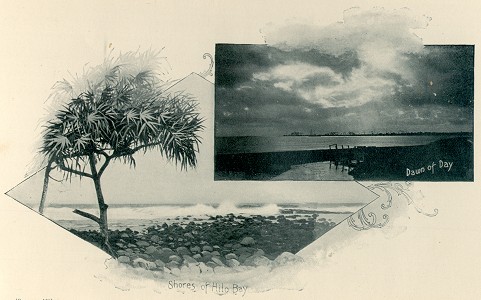
PREFACE
iv
I made a journey
to each of the islands, visited every point of interest on them, and have
endeavored to give a truthful and unbiased representation of the country,
its industries. resources, and history.
Like all countries
the islands have a story, and like all stories this one has two sides;
I heard both, and I selected what to me seems most reliable.
I wish to acknowledge
my indebtedness for information used in this volume to Prof: W. D. Alexander,
Professor Lyons, Mr. H. M. Whitney, Mr, Thomas G. Thrum, Dr. C. T. Rodgers,
Mr. L. D. Timmons
v
of The Star,
also to The Pacific Commercial Advertiser and Evening Bulletin
of Honolulu, and to Mr. Sereno Bishop, one of the oldest missionaries on
the island.
Trusting this
new candidate for public favor may meet with the success of preceding volumes
from the same pen, it is now given to the world.
Facing page 5
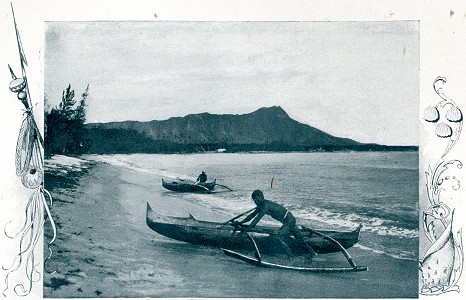
Page 15
The most popular
resort of the people of Oahu is the famous Waikiki-(Wy-kee-kee) , the accent
being on the last syllable.
Waikiki is the
seaside and pleasure-resort of the island.
It is the Long
Branch of Honolulu, its Brighton or Trouville.
There are a number
of private residences, picturesque-looking bungalows and cottages, but
all airy, comfortable, and close to the murmuring sea.
A beautiful grove
of towering coconut-trees adds to the tropical charm of the place.
The southern
portion of this grove used to be a favorite abode of the kings of Oahu
before the conquest of the island, and after that event it belonged to
the family of Kameha-
Page 16
meha the conqueror.
Bath-houses that
equal those in Long Branch are found here and sea-bathing in January is
as pleasant as in July.
There is no clearer
water, no finer beach, no smoother bottom in any of the many famous watering-places
than are found at Waikiki.
The sharks, sometime's
dangerous in the South, are seldom or never seen wiihin the reef at this
place.
Everybody who
goes to Honolulu must see Waikiki.
I had not been
in the city a week before I was induced to pay a visit to the famous Sans
Souci- the house at Waikiki which had sheltered Robert Louis Stevenson.
Boarding one
of the plain, airy cars drawn by a span of lazy mules, one afternoon, I
made the journey at an easy gait.
Such a trip is
full of interest.
From the open
car one gazes out upon the quaint houses, some European, some Oriental,
and others on the American plan.
A cosmopolitan
people are to be seen upon the streets.
I observed that
mine was the only white face in the car.
The Chinese and
Hawaiians predominated, but there was a sprinkling of Japs among the people.
At one of the
cross-streets we stopped to pick up a white gentleman, who seemed a plain,
unassuming business man.
On out into the
suburbs we were whirled, with the sea on one side, the great banana plantations
on the otber.
The half-mile
bridge, an old plantation, two very beautiful and picturesque spots, lay
on our
Page 17
left, and a romantic
forest beyond.
Innumerable native
huts, with half-naked children running about them, were on either side.
Far out to sea
was a native canoe with three fishermen in it.
The day was
fine; the blue sea, clear sky, and balmy breeze made existence delightful.
I soon became
engaged in conversation with the white passenger, whose name was Thomas
E. Evans, and who gave me consideral information, pointing out the historic
points as passed them.
He lived at the
famous house Sans Souci, and invited me to go there with him, which I gladly
consented to do.
Mr. Evans had
been a great favorite with the kings and queens of Hawaii, and is a rank
royalist.
His wife at one
time was one of the queen's maids of honor.
The manager place
showed me the room, which had been occupied by Robert Louis Stevenson,
the famous author, whose "Dr. Jeykl and Mr. Hyde" has been read by all
the English-speaking world.
He described
Mr. Stevenson as a small, nervous man, a cigarette and opium fiend.
He said he could
be quite sociable when he was in the mood, but at times was irritable.
After a bath
in the famous bathing-place, Mr. Evans and I returned to the lanai to rest
and talk.
Page 19
I remained at Sans Souci until a late hour, then walked down the broad beautiful beach road to the end of the stret car line, waited until a car came, and returned to the city.
CUSTOMS, HABITS, AND MANNERS
The Hawaiian is
indispensable to the inter-island traffic, where absolute fearlessness
of the sea is essential.
The manning of
boats at all hours, day or night, to carry passengers or freight to and
from the steamers at the various landings is done altogether by the Hawaiians.
This is a hazardous
employment, requiring skill, courage, and hardihood.
I have seen these
brave men battle for hours, in wind, rain, and angry seas, to effect a
landing at some dangerous points; I have seen their boats capsized and
crushed on the rocks along the shore, but so skilful are the boatmen that
seldom is one of them drowned.
I have often
Page 67
braved the dangers
of the sea with a Hawaiian crew, at landings and in surfs where nothing
would have tempted me to try it with a crew of white sailors.
They swim like
fish, and the capsizing of a canoe or boat is a matter of indifference
to them.
They are the
only deep-sea fishermen, and often go in their frail canoes out of sight
of land, but rarely fail to return.
The sea has done more for the native, in developing skill and ingenuity, than the land.
Page 71
As a fisherman
the Kanaka exceeds all others.
The moment he
decides to "go a-fishing" he is a new being.
He is awakened
from his lethargic state, and alertness, judgment, and enthusiasm mark
his every movement.
He makes his
preparations with great patience and minuteness.
He overlooks
nothing that will contribute to his success.
His canoe is
put in trim, his lines are all inspected, and his whole house-hold enlisted
in the capture of crabs on the rocks and in their hiding-holes.
He seems guided
by instinct as well as skill in securing his bait.
There is no more
fascinating sight than the Kanaka launching his canoe, and guiding it with
his paddle, as he rides supreme on the threatening swell that breaks with
revengeful roar behind him, just as he slips gracefully from its crest.
He is in his
element.
He laughs at
the raging beach-combers as he deftly turns between them, and races his
canoe through a strip of unbroken
Page 72
water, out of
range of danger, into the deep sea.
It takes him
a moment only, but you stand spellbound at his prowess.
No more is he
the indolent native lying so lazily and comfortably on the velvety manie-nie
grass yonder by the grass house.
He is a hero,
with a manual skill little less than marvelous.
His contest with
the sea, necessitated by the craving for what the sea could supply, has,
from early days, been the chief stimulus in the development of Hawaiian
character.
It has called
out skill, courage, sagacity, ingenuity, and abilty to endure and conquer.
It has promoted
a knowledge of navigation, and led to a minute and accurate observation
of winds, currents, and channels, lent scope and fervor to the imagination,
and set aflame the poetic spirit of the race.
The old songs
and most cherished traditions are replete with references to the sea.
The sea is the
Hawaiian's classic, from which have come the seven wonders of his legendary
world, and on its foam-crested billows, never to return, have departed
the adventurous spirits of his race, aglow with the ardor of discovery
and conquest.
Not only does
the sea furnish the Hawaiian with food and employment, it also affords
him his chief amusement.
Surf-riding is
an old and heroic sport for which Hawaiians have always been noted.
In ancient times
it was practised in honor of the kings and chiefs, but since has become
a royal sport on its
Facing Page 72
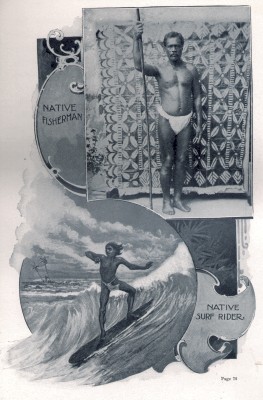
own account.
The surf-board
is a long, thick plank, carefully shaped, with ends rounded, on which the
native rides on the crest of the great billows rolling shoreward.
The skill consists
in mounting the wave at an opportune moment, and in keeping the surf-board
in such relation to the movement of the billow so that the latter will
propel the rider at a tremendous speed toward the shore.
Expert surf-riders
will rise as they rush along until they stand erect with folded arms, complete
masters of the waves, which they seem to drive before them like chariot-steeds.
Tho not witnessed
so frequently as formerly, surf-riding is still a popular sport on some
of the islands.
Many of the ancient
Hawaiian games such as coasting, rolling quartz, and bowling are lost arts
to the present generation, who have substituted baseball, football, and
more modern sports.
Tho one can not
but feel sad when any sport truly heroic passes from the knowledge of man,
yet the sports of the present generation indicate that the Hawaiians have
begun to adopt modern thought and methods.
Visitors to Honolulu
note the ease and self-possession of Hawaiian boys in the water near the
wharves at the departure of ocean steamers.
Tossing nickels
in the water to see the boys dive for them is common sport.
They seldom fail
to catch a piece of money before it sinks, tho it is tossed in the water
several feet from them.
I have seen boys
with their mouths
Page 74
full of nickles
and dimes caught while sinking.
The natives never
fail to know when a shark is in the harbor, and are rarely caught.
Page 111
(Musick accompanies
a large party of officials on visit to the leper colony on Molaki)
As we descended
the hill and came in sight of Kalaupapa, we noticed that the surf was rolling
high.
A boat was just
pulling out from the shore to the Ke Au Hou, at anchor a fourth
of a mile away.
"The wind is rising,"Dr.
Capron said while a shade of anxiety passed over his face.
"If we go aboard
that ship to-day we must do it very soon."
Putting our horses
to a gallop we thundered down toward the beach.
One of the ship's
boats containing Captain Thompson, Purser Kelley, and a native crew, pulled
out from the "rock pen" and started toward the ship.
A mighty wave,
seeming mountain high, rolled toward it, struck the prow of the boat with
such force as to capsize it, and the officers and crew were struggling
in the rolling surf, which for a moment buried them.
The boat was
lifted on the top of a foam-crested wave, and rolled over and over on the
rocks until it was crushed as if it had been an egg- shell.
Fortunately,
the skipper and crew were swept on the rocks with only a few bruises, and
all miraculously escaped.
By the time we
drew up our panting steeds along the stormy beach, the captain and his
crew had crawled out of the water.
They gave us
the encouraging intelligence that the provisions brought from the ship
had been lost in the sea, by the capsizing of
Page 112
a former boat, and the prospects tor a continued fast on the lsland were excellent.
The question that
most concerned us was how we were to get on board the ship.
The surf was
dashing with increased violence every moment, and while the capsizing of
the captain's boat might be regarded in
the light of
an accident, there was no doubt that an attempt to reach the ship would
be attended with great danger.
We returned to
the guest-house, whither the others had gone, and held a consultation.
Chief-Engineer
McLean, Purser Kelly, and Captain Thompson determined to manage in some
way to get the commander of the craft aboard.
The captain,
purser, and crew took their place in the second boat, and a native named
Hikiau stood holding the bow-line while he watched the great waves roll
in shoreward.
It was a thrilling
moment.
The captain whispered
some words in the ear of the chief engineer, who was to remain behind,
and placed his watch and purse in
his possession.
His face was
very pale, but he was calm, and on his brow was stamped that determination
that makes heroes.
Hikiau kept his
eye on the rolling waves, that broke in crested splendor with the roar
of thunder upon the rocks, occasionally giving a word of command to the
crew in the boat bobbing up and down in the rock pen.
Three great waves had just exhausted their force on the shore when Hikia gave a shout, released the
Page 113
cable, and the
boat shot out of the rock pen to dash into the roaring surf.
The natives on
the dock , cheered the native sailors, who fearlessly bent to their oars,
sending the boat bounding over the waves. One monster, angry billow came
rolling forward with such fury that it seemed as if it would inevitably
bury the boat beneath it.
The prow of the
boat mounted it, and at one time the craft seemed to be almost perpendicular,
in fact so much so that those in the boat had hard work to hold their places.
It swept over
the wave, and the prow dipped down into the trough of the sea, and the
stern kicked up its heels with such force as to threaten to throw the passengers
out over the bow.
The boat swept
safely on, however, and was soon in smoother water.
Everyone who
had held his breath during the danger now gave vent to wild cheers, answered
from those of the crew on the ship. The captain and his boatmen were soon
safely on board the ship, but the gale was increasing and the surf growing
more and more dangerous.
The Board of Health
decided that it would be impossible for us to go aboard the ship from the
Kalaupapa side.
Some thought
that on the other side of the peninsula, at either Kalawao or Waikolu Point,
the sea would be smooth enough for the ship to approach the shore.
Ambrose Hutchins
sent a horseman flying over to the other side to ascertain the condition
of the sea there.
I could not endure
the thought of
Page 114
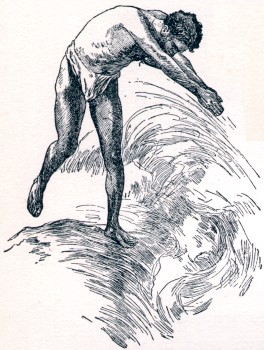 |
spending a night
on this horrible island, and was almost tempted to plunge into the rolling
surf and swim to the ship, or perish in the effort.
In an incredibly
short time the messenger came flying back with the glad news that the sea
was calmer on the other side.
"Write it out,
put it in a bottle, seal it, and give it to me," he said.
|
Page 115
a cloud of spray
hid everything from view.
So long was he
hidden by the waves that even the most experienced feared he was lost.
At last he rose
triumphant on the other side, and struck out for the ship.
Another and another
billow came rolling toward him, and he mounted them with the ease and grace
of a swan, while wild cheers rose above the thunder of the sea.
He finally reached
deep water, and with a few powerful strokes darted through it like a seal
and reacfied the ship's side.
A rope was thrown
to him, and with agility as a climber exceeded only by his skill as a swimmer,
he reached the deck.
A few minutes
after he reached the deck the steamer hoisted anchor and steered for the
opposite side of the peninsula.
Again we mounted
the horses and thundered over the hill to Kalawao, accompanied by three
or four hundred lepers, far more sociable than was agreeable.
The very streets
of the village were filled with the stench of leprosy, and I determined
to get off to the ship that night if it was possible.
The sun was already
low in the west, and the sky, which at noon had been clear, was overcast
with lowering clouds, while the eternal roar of the surf fell on our ears.
Musick and his party
are unable to board the Ke Au Hou at Kalawao, or at Waikolu
Point where eight passengers where able to board before the conditions
deteriorated even further.
Forced to spend
an uncomfortable night at Kalawao, the party was forced to cross the island
via the pali, and meet the steamer at Kaunakai.
Page 168
Another attraction
at Hilo is Coconut Island, where tall, graceful coconuts grow in abundance.
Surrounded by
the dashing sea, it forms a picture that is artistic and beautiful, and
makes
Page 169
it a favorite object fot the amateur photographer.
Page 225 AT KAILUA (Hawaii)
Perhaps in no
place can the native Hawaiian be found more nearly in his primitive state
than in Kailua.
Men and women
fishers clothed only with the malo were seen about the beach with their
nets and spears.
I saw one man,
at a single cast of his net, sweep in seventy-five mullet.
A woman, perfectly
Page 226
naked save the
malo, was creeping around in the shallow water gathering a sort of mollusk,
called the sea-urchin, from the rocks. The sea-urchin is a burr-like mollusk,
with stubby tentacles or legs, which move slowly when out of the water.
She had a basket
nearly filled with them and was taking them home to supper.
A man with a
spear next attracted my attention.
He was wading
in the shallow water, thrusting his spear into the holes in the rocks,
and bringing out many quaint and curious specimens of the finny tribe.
While I watched
the fishermen, school was dismissed for the day, and the children of both
sexes from five to fifteen years of age came running to the dock, where
they disrobed themselves, and, nude as our original parents before the
first sin, plunged into the water.
Their screams
and shouts of merriment soon drew some gentlemen to the dock, and the little
rascals began to cry for nickels. Several coins were tossed one at a time
into the water, and they invariably caught them before they reached the
bottom.
The surf was
rolling considerably, and some had logs of light wood, and one or two surf-boards.
One of the most
interesting sights I witnessed was a little girl, eight or ten years of
age, riding the waves on a log.
The waves gave
the log the undulating motion of a rocking-horse, and she screamed with
delight, and brushing her long, dark, and damp tresses from
Page 227
her face, shouted
to her companions to catch her if they could.
The older boys
were exercising on surf-boards, and one standing upright was whirled to
the shore with fearful velocity, - then my thoughts went back to the old
pictures in the geography, and I said: "It was true."
Page 361
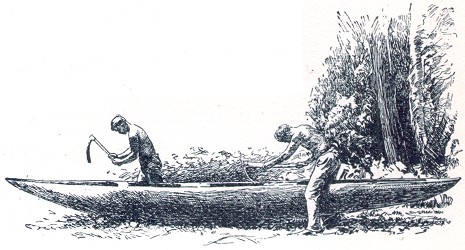
Page 447
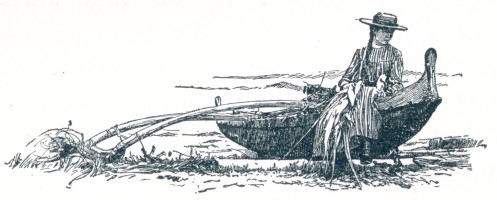
FEBRUARY I, 1896, the day of my departure from this delightful country, dawned bright and clear.
478
The water about the AustraIia was alive with boys swimming like fish, or sitting upright, calling to the passengers to toss their nickels in the water and see them dive for the coin.
When a gentleman
made a motion to throw a small coin this way and that, the water was all
commotion.
The heads glided
here and there, the flying hands and feet beat the sea to a foam.
The gentleman
at last tossed the coin far away from any of them.
There was a loud
splashing and naked legs and feet disappeared under the water.
There was a great
swirling and commotion as if submarine monsters were battling, then the
waters grew more calm, and only a ripple here and there told where the
divers had disappeared.
A few moments
elapsed, and then a head appeared, and then another and another, until
Page 479
all were once
more above the surface.
One boy bobbed
up half-way out of the water, and holding the coin aloft in his hand cried'
"Here's yer neekel!"
A cheer for the
successful diver went up from the deck, and other nickels were tossed into
the water for the divers to catch, and not one was lost.
NOTES
1."my thoughts
went back to the old pictures in the geography, and I said: 'It was true,'"
page 227.
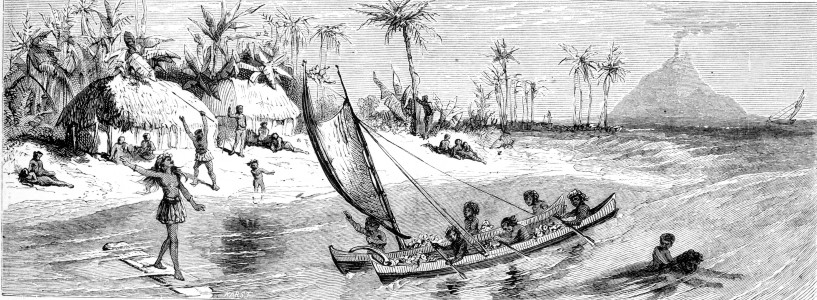 |
Scene in Polynesia. in Swinton, William: Grammar School Geography Ivison, Blakeman, Taylor, and Company New York and Chicago, 1881, page 105. |
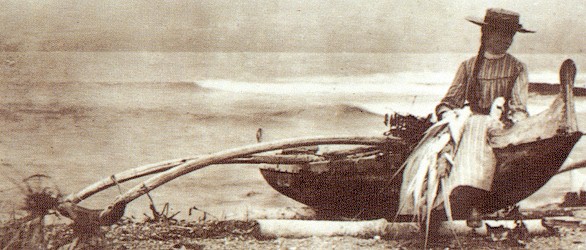 |
Photograph Charles Furneaux, Bishop Museum. Cropped Holmes: Hawaiian Canoe (1993), page 77. Surfrider's attention will focus on the two waves on the right hand reef in the background. |
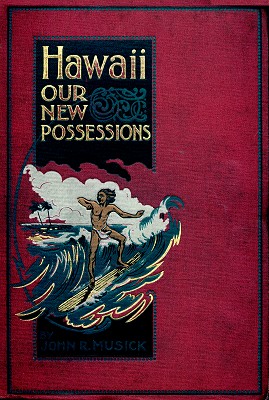 |
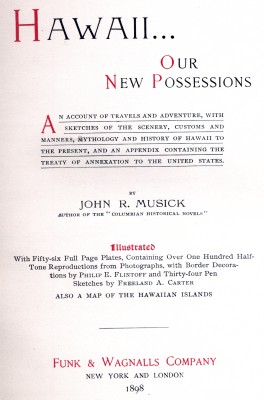 |
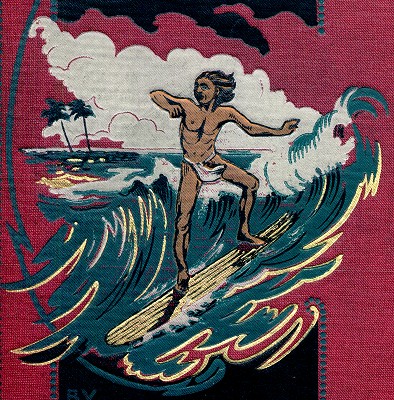 |
Hawaii - Our New Possessions. Funk and Wagnalls, New York, 1898. Above: Cover and title page. Left: Cover detail. |

| home | catalogue | history | references | appendix |